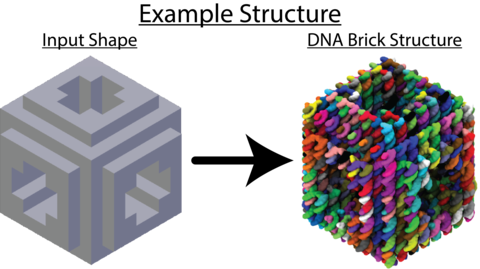Using LegoGen to build DNA Brick structures
Access LegoGen at Nanohub here. You will need a Nanohub account in order to use LegoGen.
In the tutorials below, we go through building several DNA brick nanostructures of varying complexity. DNA brick structures are largely similar to DNA origami structures, but differ in the average number of helical connections and in strand length. DNA brick structures use a standardized 32-nucleotide-long "brick" strand that is repeated throughout the structure, unlike DNA origami which uses a single long scaffold strand and numerous custom staple strands. The junctions which bind adjacent DNA helices together are different as well: DNA origami structures have two connections and form a traditional Holliday junction, while DNA bricks have only one connection and form a non-traditional junction.
DNA bricks, due to their repeating pattern, can be used to construct a large variety of unique shapes and structures all from the same library of strands. With the DNA origami method, any change to a structure requires entirely new staples. With the DNA brick method, changes require new strands only locally around the changes, allowing for a modular and iterative design route.
Using LegoGen, one can design a 3D model of a desired shape and automatically convert the model into an atomic DNA brick model. The locations of helical connections and the nucleotide sequence of individual strands do not need to be specified, as LegoGen determines all of that for you. If you would like more control over the sequence, that is possible that as well.
Multiple tutorials for LegoGen exist. If you would like a rapid introduction to LegoGen, watch the video below. A more in-depth tutorial exists in PDF format if you would like to know about designing more complex structures.
